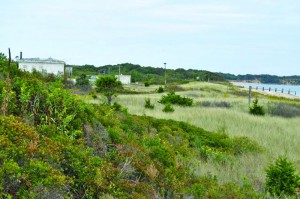Tour takes in Plum Island’s beauty

The clock is ticking on the future of Plum Island, and environmental advocates have banded together to fight to preserve the 840-acre property.
The island, just east of Orient Point, has been the site of the U.S. Department of Agriculture’s Plum Island Animal Disease Center since 1954, though work there has been overseen by the Department of Homeland Security since 2003. The federal government last year announced plans to sell the island and build a more high-tech animal disease research facility in Kansas.
Last Wednesday, Oct. 6, the Department of Homeland Security gave a tour of the island to a group of environmentalists.
The tour was conducted for the Long Island Sound Study Group, a cooperative effort of the U.S. Environmental Protection Agency and the states of New York and Connecticut, which has named Plum Island a significant estuary. Also on the tour were members of Preserve Plum Island, a Long Island-based coalition of 36 environmental groups ranging from local groups to the international Wildlife Conservation Society.
Preserve Plum Island is asking the Department of Homeland Security to transfer the wild portion of the island to the Fish and Wildlife Service as a nature preserve.
It wouldn’t be the only preserve in the area, which is an important flyway for at least 100 species of migrating birds. Great Gull Island, just to the east of Plum Island, is a bird sanctuary and a tern study area run by the American Museum of Natural History. Another small rocky outcropping known as The Ruins, once part of Gardiners Island, was given to the Fish and Wildlife Service last year.
“I think they’re interested. They’re in the area,” said Nature Conservancy policy advisor Randy Parsons of the Fish and Wildlife Service. Mr. Parsons was on the tour last Wednesday.
He said that The Nature Conservancy is pushing the federal government to complete a four-season biological inventory of the plants and animals on the island before the sale can be completed. The U.S. General Services Administration, the agency responsible for the sale of the island, is in the process of compiling a draft environmental impact statement detailing environmental issues that must be addressed before the sale. The EIS was initially expected to be complete this month but has been delayed until later this fall.
Environmental contamination on the island is a potential stumbling block for the sale. Mr. Parsons said that the U.S. General Accounting Office has documented several dozen toxic contamination sites on the island and has estimated the clean-up costs at as much as $190 million.
“There is definitely the feeling that the federal government shouldn’t be trying to market this thing. They should be cleaning up the mess and restore the island to its pre-U.S. government condition,” he said. “But I don’t think a lot of this would have come to light if they weren’t going to sell it.”
Stella Miller, president of the Huntington-Oyster Bay Audubon Society and a founder of Preserve Plum Island, was also on Wednesday’s tour. She said she was particularly impressed by a visit to a rocky outcropping on the island where 50 seals were hauled out on the rocks. She said that as many as 300 seals haul out at Plum Island at one time.
“Birds travel thousands of miles during migration and spots like Plum Island are necessary for their survival,” she said.
She said that tour participants were given an overview of work done on the island but that her tour guides were not interested in discussing the future of the facility, despite the fact that the visit was widely described in the media as a real estate open house.
“They didn’t go there,” she said. “They stayed neutral.”
GSA representative Paula Santangelo also remained stoic in her agency’s position on the future of the island.
“While the EIS will present several re-use scenarios, GSA doesn’t advocate any particular reuse,” she said Friday.







